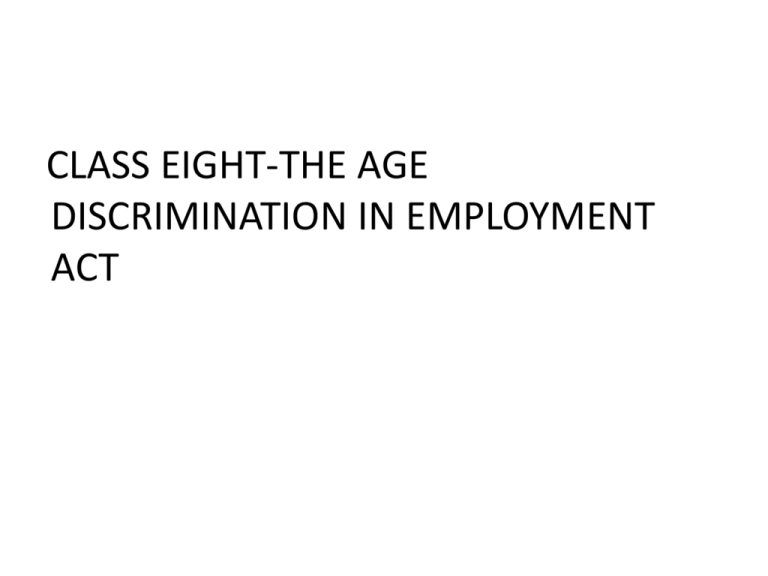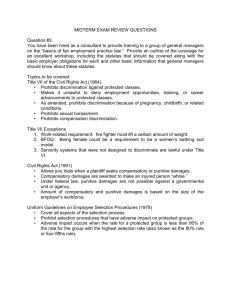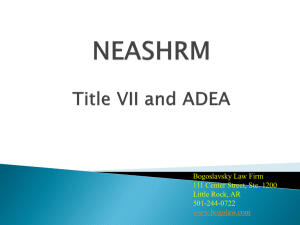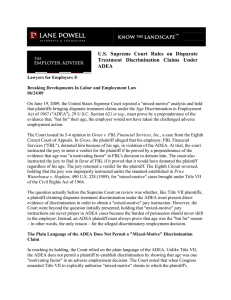age discrimination in employment (adea)
advertisement

CLASS EIGHT-THE AGE DISCRIMINATION IN EMPLOYMENT ACT AGE DISCRIMINATION IN EMPLOYMENT (ADEA) • Age Discrimination in Employment Act of 1967 – Covers all aspects of workplace discrimination such as: hiring assignments, promotions, work environment and discharge • Age Discrimination Act of 1975 – Applies to employers that receive federal grants or assistance. • Federal age discrimination law covers workers 40 and over. State laws cover people as young as 18. Federal law does not protect against reverse age discrimination, but some state laws do provide this type of protection. How The ADEA Works • The ADEA does more than protect people over 40 from discrimination in favor of people under 40. For example, if an employer, by reason of ageism, denies a promotion to a qualified 55-year old and gives the job to a 45-year old, there is unlawful age discrimination. • Age discrimination is relatively easy to prove where there is a blatantly ageist remark by a decision maker, but age discrimination is usually subtle rather than blatant. Moreover, where the same person who hired the older worker makes a decision to discharge him, the action is less likely to lead to an inference of age discrimination. Nieto v. L & H Packing Co., 108 F.3d 621 (5th Cir. 1997). COVERAGE UNDER THE ADEA Who is covered (and not covered): • Employers, employment agencies and labor organizations are covered (29 USCA §623(a) – (c)) • Supervisory personnel in individual capacity – Majority of federal courts have held that ADEA provides no basis for relief against supervisory personnel in their individual capacities unless otherwise qualifies as “employer” under the statute. PROVING AN AGE DISCRIMINATION CLAIMSlide 1 Elements of prima facie case – Disparate Treatment, using preponderance of evidence standard: 1) Plaintiff discharged or suffered an adverse employment action 2) Plaintiff within protected group (age 40 or older) at time of discharge or adverse employment action 3) Plaintiff qualified to do job from which he or she was discharged or in which he or she was adversely affected 4) Plaintiff replaced by someone outside protected class and replaced by someone younger (or otherwise show that he/she discharged or suffered adverse effects based on age). PROVING A DISCRIMINATION CASE-Slide 2 Elements of a prima facie case based on a reduction in force – courts use different Standards • Plaintiff must show that discharge or layoff had a specific impact on workers within their protected age group, as compared with younger workers by showing: 1) Plaintiff was discharged or laid off 2) Plaintiff was within ADEA’s protected class at time of discharge or layoff 3) Plaintiff qualified to assume other position 4) Circumstantial or direct evidence leads a fact finder to reasonably conclude that employer intended to engage in age discrimination in discharging or laying off plaintiff. PROVING A DISCRIMINATION CASE-Slide 3 Elements of a prima facie case for hostile work environment – Employer is liable for the actions of a supervisor towards an older employee if those actions are considered to be harassment. Standards for hostile work environment claim: • Plaintiff must be at least 40 years of age • Harassment must be age related • Harassment must be unwelcome • Harassment must affect a term or condition of employment, and • Employer knows, or should know about harassment and fails to take prompt, effective action. EMPLOYER’S BURDEN OF PROOF IN ADEA CASES An employer can defend an adverse employment decision taken against an older worker if it can show that it was based on reasonable factors other than age. For example, it is lawful for an employer to enact a reduction in force based on a need to eliminate higher salaried positions; in other words, it is lawful to make decisions based on economic factors, even though a disproportionate number of higher salaried employees are older. DiCola v. SwissRe Holding, 996 F.2d 30 (2d Cir. 1993). Although it is not advisable for an employer to tell a prospective employee he is “overqualified,” one employer got away with doing so. See EEOC v. Ins. Co. of North America, 49 F.3d 1418 (9th Cir. 1995). PRETEXT IN ADEA CASES Once employer rebuts presumption of discrimination, the burden of persuasion falls back on plaintiff to show that reasons articulated by employer are not true, or constitute a pretext for discrimination. Employers’ conduct is considered to be a pretext if that conduct is: • Arbitrary, capricious, or nonsensical • Jokes or insults aimed at a person’s age • Comments made are close in time to the adverse event Disparate Impact Theory • In Smith v. City of Jackson, 544 US 228 (2005), the Supreme Court held that the disparate impact theory was available in age discrimination cases. A police department had an incentive pay plan designed to bring salaries of police officers up to the regional average. All officers received some raises, but those on the force less than five years got larger raises. Although some of the over-40 police officers had been on the force less than five years, most were under 40. When a group of older officers sued the court dismissed the action, holding that they had failed to isolate a specific employment practice that had a disparate impact on older officers. REMEDIES AVAILABLE UNDER THE ADEA Remedies in ADA cases 1. Back pay, including the value of lost benefits, reduced by any wages and benefits that the employer earned at another job (employees have a duty to mitigate damages). 2. Reinstatement, or front pay (loss of future wages) where reinstatement is not feasible. 3. Liquidated damages in case of willful discrimination. See Trans World Airlines v. Thurston, 469 US 111, and Hazen Paper Co. v. Biggins, 507 US 604. 4. Attorneys’ fees.






